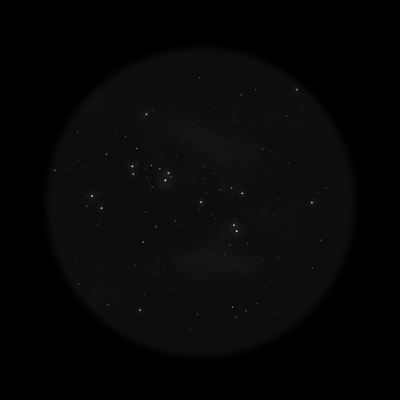
Cr 249 = Lambda Cen cluster is a bright group of two dozen stars elongated NW-SE, ~12'-15' diameter, centered ~30' SE of 3rd magnitude Lambda Cen. Situated in the midst of a fascinating field of nebulosity and dark lane which run just north of the cluster and which spreads out to the east of the cluster! The field seems riddled with dark lanes and brighter patches. Mag 6.5 HD 101205 is near the center of the group and a mag 7 star lies 4.6' NW.
10x30mm Canon IS (3/28/19 - Tasmania): prominent region in 10x30 binoculars. Includes Lambda Centauri and 4 bright stars in a string to the southeast. These stars are involved in an extremely large nebulous haze (unfiltered).
Royal H. Frost discovered IC 2948 = F. 790, along with IC 2944, on a photographic plate taken 5 May 1904 with the 24-inch refractor at the Arequipa station. He noted nebulosity only. See notes on IC 2944.
H.E.W. described the region in 1910 at the Union Observatory in Johannesburg, probably based on a photograph taken with the Franlin-Adams camera. "A very large nebulous region - irregular n shape, somewhat resembling a pear. The star Lambda Centauri is involved in the nebula at the narrow end of the of the pear. The stars CPD -62°, 2154, 2168, 2164, 2186, 2184, 2206and 2142 are also surrounded by nebulosity. There are rigts through the nebula breaing it up into three main portions. The bright portion of the nebula covers about 40' in declination and 5 minutes in RA, but there are fainter extensions about 1° from the main body."
300/350mm - 13.1" (2/18/04 - Costa Rica): this is a bright and fascinating HII region southeast of Lambda Centauri using an OIII filter and a 20mm Nagler combination! Surrounds open cluster Cr 249 (notes below), which is encased in nebulosity. Additional haze extends beyond the cluster towards the southeast for several arcminutes. At this point there is a sharp bend and a bright section of nebulosity extends to the north. This section is wider and brighter than other regions. The brightest sections roughly form a huge "7" shape, perhaps 30' in size! This object is referred to as the "Running Chicken Nebula" and photographs reveal several embedded Bok globules.
Notes by Steve Gottlieb